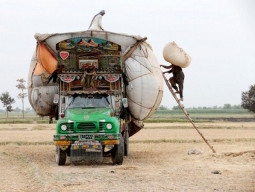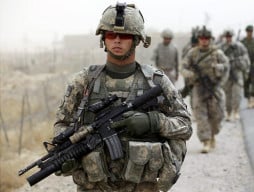
Former US secretary of defence Robert Gates, while writing in his memoir Duty — Memoirs of a Secretary at War states that one of his favourite sayings has been “never miss a good chance to shut up”.
I was reminded of this statement when just the other day I heard the Afghan president say, “The keys to war [in Afghanistan] are in Islamabad, Quetta and Rawalpindi.” He also questioned, “If the Afghan government is illegitimate, where does the Taliban get their legitimacy from?”
This ‘political posturing’ and the audience-driven statement by the Afghan president at a time when the Afghan peace process is at a very sensitive stage does not augur well for the whole process.
So far both the US and the Taliban have agreed in principle to a framework of peace dialogue, and the next and the most important stage is the likely consent by the Taliban to agree to observe a ceasefire and also open up dialogue with the Afghan government.
Three factors stand out as the most critical in the current peace process — time, the attitude of Afghan government, and the vulnerability of the Afghan people.
There is this Washington clock and there is this Kabul clock. Unfortunately, both are not ticking together. While the Americans are in a hurry, Afghanistan needs a very long time and effort for a political reconciliation.
The outer surface of the peace deal looks very lucrative but it’s the inside of the deal — the contextual and the circumstantial concerns that are vital to be addressed and secured — political, economic, ethnic and most importantly, gender concerns, the concerns of the women in Afghanistan.
One great lesson that the US forces learnt in Afghanistan drawn out of its CHB (clear, hold and build) strategy was ‘not to clear what you can’t hold’.
The fear is that once the path of peace will be cleared the Afghan government and its defence forces without the American forces’ presence and with the resources at their disposal may not be able to hold the managed peace together.
Ironically, it took the US 17 years to wrestle with the idea of what it would take to defeat the Taliban.
In these 17 years, Americans tried everything for a military victory — the initial air campaign and counterterrorism strategy, Donald Rumsfeld’s ‘light foot print strategy’, Vice President Joe Biden’s ‘Counterterrorism plus strategy’ (hunting al Qaeda leadership in Afghanistan and Pakistan), Gen Mc Chrystal’s ‘Counter Insurgency’ and even Gen Petreaus’ ‘Anaconda Strategy’ (squeeze life out of militants and insurgents like the giant snake). T
he question being asked at this stage is: if Americans could not achieve a military victory despite their huge military presence, how can they achieve this political victory of some sort with their zero presence on ground? Is this policy of peace being tailored only to fulfil a president’s campaign promise and an American president’s current agenda?
Has an ‘Afghan alarm’ been set on the Washington clock timed with the president’s State of the Union address? Would the Americans care about the Kabul clock and how painfully slow it may tick with dire consequences for its people?
The second factor — the attitude of Afghan Unity government is important because so far they have not been able to speak with one voice. Many experts think that politics in Afghanistan will get more divided when the peace process reaches the stage of ‘what to do’ and ‘how to do’ and in what time frame? For the Taliban politics has been an activity “to kill or be killed”.
To indulge in a dialogue with a movement that inflicted untold suffering on the government and its security forces will not be easy. Emotionally there are likely to be more excuses with the government to quit the process than the logical tendency and reason to proceed forward and take it to a logical end.
Another factor when compared relatively to how it was possible for Americans to achieve peace in Iraq was the geography. Insurgency in Afghanistan is rural (40,200 villages with only 30% of the near 400 districts in Afghanistan considered safe) as compared to urban in Iraq.
The terrain in Afghanistan is more difficult and so have been the ability and the capacity of the Afghan government to reach out to the people in the entire country.
There are many ‘political polluters’, the political spoilers and the return to normalcy for them may mean the beginning of the end of their political control and authority.
A typical tribal state — given the cost they may have to pay, many tribal leaders and the warlords in Afghanistan may be absolutely on the other end of the spectrum of the peace process.
Lastly, what about the people of Afghanistan and their possible future vulnerability? The Soviet Union with a force size of 120,000 could not politically secure Afghanistan.
With 15,000 soldiers dead, it left the country to deal with itself and its future. When Americans decided to take this upon themselves to bring about some political order and political control in Afghanistan, they also followed the Soviet Union model — military intervention in Afghanistan.
The US launched an air campaign in Afghanistan within 26 days of the September 11 attacks, their forces were on ground in Afghanistan within 38 days of the attack and the Taliban government was overthrown in Kabul within 63 days of the 9/11 attacks.
During all this time, the size of US troops in Afghanistan never exceeded 4,000 troops. Ideally, that’s the minimum size of American troops that must remain in Afghanistan to manage the political stability and sustainability which is so important for the safety and security of Afghan people.
President Trump’s decision to withdraw from Afghanistan is based on his assumption that ‘our politics seems more interested in defending the borders of the foreign countries than our own’. He calls Afghan war ‘a complete waste’.
Is it a case of ‘America first’ or is it a declining power reducing and ending its peripheral commitments? Both ways when the end (withdrawal of American forces) comes — it should not be in haste.
Post Script: Without American forces President Ghani and his government will be like a golfer with only a putter and 9 iron and asked to shoot a par.
Published in The Express Tribune, February 3rd, 2019.
Like Opinion & Editorial on Facebook, follow @ETOpEd on Twitter to receive all updates on all our daily pieces.




















































COMMENTS
Comments are moderated and generally will be posted if they are on-topic and not abusive.
For more information, please see our Comments FAQ